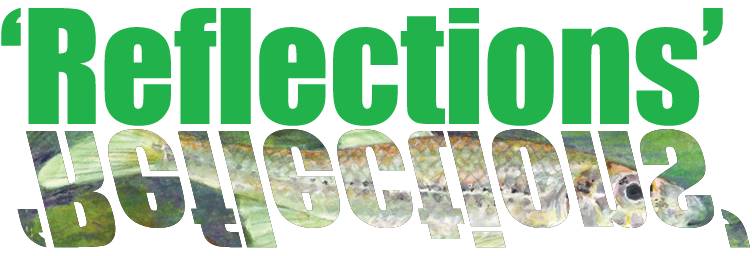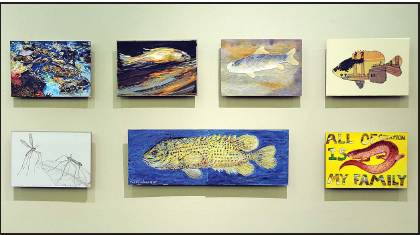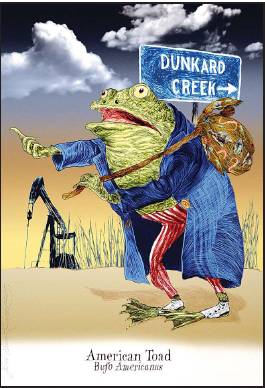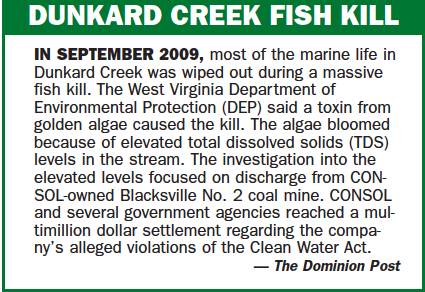Exhibit Pays Tribute to Life Lost in Creek
Morgantown Dominion Post
8 September 2011
By Lindsey Fleming

The opening reception for “Reflections: Homage to Dunkard Creek”
is set for 6-9 p.m. Friday in the Jackson Kelly Gallery of Arts
Monongahela at 201 High St. For more information on the exhibit,
go to http://web.me.com/paynestake/Homage_to
_Dunkard_Creek/
On a warm, damp summer day two years ago, Anne Payne stood, waders
on, knee-deep in the middle of her friend Wendy’s problem, one the
Mount Morris, Pa., resident had been imploring her to check out
for a while.
“She kept saying, ‘You’ve got to come out. There’s something wrong
with my creek,’ ” Payne said. “I’m like, ‘What am I going to do
about her creek?’ ”
But the Morgantown artist knew, after witnessing the Dunkard Creek
fish kill firsthand, she was going to have to do something.
White carcasses floated somberly downstream. Log jams of the
living, seeking fresh water, were so desperate to reach the tiny
rivulets trickling with it, they suffocated while throwing
themselves on top of one another.
Mudpuppies, “with their little black paws,” crawled up the banks
to escape.
“That was it for me. I could have heard about it ’til the cows
came home, but to stand there and see, it just made you want to
weep.”
Instead of weeping though, Payne decided she must educate herself.
She began attending meetings about the massive kill and its
implications. She researched the more than a 100 species of fish
and mussels officially wiped out due to a toxin in the 2009 golden
algae bloom, as the result of increased levels of total dissolved
solids from mine discharge. And she found out about others — such
as insects, salamanders and frogs — that no one she contacted in
an official capacity confirmed for certain perished. It was the
non-experts, the residents along the creek, who provided her with
lists of those creatures, as well as historical records she
uncovered.
Friday, artwork depicting 90 of those species, created by an equal
number of artists, will adorn the walls of Arts Monongahela during
the opening reception of an exhibit which pays tribute to their
lives. There will also be photos of the creek, information about
the species and the fish kill, an interactive display and a video
of residents along the creek speaking about how the kill affected
them.

The seeds of “Reflections: An Homage to Dunkard Creek” have been
in the works since not long after Payne’s visit to her friend’s
property. It was then when she made the ambitious decision to
paint 116 of the species that were affected. By 2010, she only had
10 pieces completed.
“I’m thinking, I’m 69 years old, let’s do the math here. No, this
is not working,” she said, laughing.
So, when a friend suggested she get someone else to help, she ran
with the idea and decided to randomly assign a species to a number
of fellow artists. Ninety, she said, seemed like a nice round
number.
“I could probably have gotten famous artists from afar who are
activists to participate but I thought, ‘You know, I wanted to be
kind of in a family of artists who have the same physical
connection to the [Monongahela] watershed.’ ”
And that’s when the onslaught of calls began.
She started with Ron Donoughe — a plein air painter she had no
connection with, other than she had seen his work and thought it
would be appropriate. He happily agreed. As did all of the
participants she contacted, which include practicing artists who
live, attended school or have vacationed in the area surrounding
the watershed.
“It’s a big network of people [who are] made of the same water,”
she said of the dozens of artists who hail from Boston, Mass., to
Charleston and many points in between. “We drink it. It falls on
us when it rains. Everybody felt the same connection to this in
varying degrees.”
“In some ways Ann looked at the watershed and saw it as an artshed
too,” said Brent Bailey, director of the Appalachia Program at The
Mountain Institute, a nonprofit organization which sponsors the
exhibit. “This is a whole community of people, [some of whom] have
never even met each other, but are all tied to the same piece of
land. There’s a real heart response here for many of them.”
It’s something Payne realized quickly, during her recruiting
efforts.
“A lot of people, I felt like they almost said, ‘Gee, we’ve been
waiting for your call,’ ” she said.
She said many became acquainted with their assigned species —
which range from algae and large mouth bass to muskies and
Fatmucket Mussels — for the first time. Even those who had
initially expressed concerns about their picks, finding them
boring, ugly or both, came to appreciate them. Some searched the
Web. Others spoke with fishermen and professors to learn more. And
a fair amount traveled to the Carnegie Museum of Natural History
in Pittsburgh to study specimens up close and personal.
The result of such efforts is an abunwork as varied as the species
they represent. Lithographs, prints, watercolors, oils and more,
portray the kaleidescope of colorful life just underneath the
water’s surface and range in tone from whimsical to contemplative.
In an effort to make the traveling exhibit portable,
cost-effective and adaptable to different spaces, Payne required
each artist to create on the same sized surface — a
10-1/4-inch-by-7-inch masonite art board covered with French
watercolor paper.

“It’s something that anybody can do without enormous resources,”
she said. “I made it to go in the back of a car.”
For the next two years, “Reflections” will be on display in
several galleries around the region. And if all goes well, even
farther. The idea is to provide an exhibit that is accessible, so
that anyone inspired by it can welcome it to their community or
easily duplicate it.
This accessibly and the creative spin “Reflections” puts on the
larger environmental issues of water quality and energy use, are
at the crux of why The Mountain Institute partnered with Payne in
its first artistic endeavor, according to Bailey.
The institute, active in West Virginia since 1972, focuses much of
its efforts on environmental education in schools. With
“Reflections” the organization saw a way to reach a broader
audience.
“It’s a really great way to raise awareness,” Bailey said. “This
seemed to be a part of that conversation about energy and water
and how they collide. ... Water is probably the greatest resource
that comes from mountains. And everything springs from the
mountains and we feel like this is just an important resource that
needs to be highlighted.
“And how do you get the public to really take an interest in
something that is so valuable but probably so underappreciated?
Creating this kind of an opportunity for public engagement, to
come and learn and talk about it, seems like a really great way to
further that awareness and that understanding.”
Though the exhibit is intended to spark debate and raise
questions, that’s only a part of what “Reflections” is meant to
inspire in viewers.
“Let’s start with appreciation of what we have. And how we deal
with it will be based on an understanding, an appreciation of
what’s here rather than just looking at numbers and figures,”
Payne said, referring to the fish kill and its future
implications.
She added, “part of that honoring [of the species] isn’t just to
wring our hands and worry. It’s to say, ‘They’re amazing. They’re
marvelous. They’re beautiful. They’re funny. They’re interesting.
They’re useful.’ And at the same time, the humans who created them
are the same way. It’s that interaction. And that’s not about
death. That’s about life.




